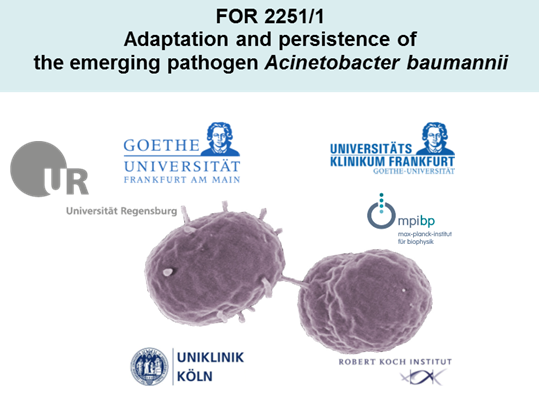
Adaptation and persistence of the emerging pathogen Acinetobacter baumannii
Multi-resistant bacteria have increased dramatically in recent years in clinics and pose immense, deadly problems for staff and patients. In addition to "old acquaintances" such as Staphylococcus aureus, a new one has been added in recent years: Acinetobacter baumannii. Although it was only occasionally detected in a few years' time, it has now also made a triumphal progress through industrialized countries. It is the cause of 5-10% of pneumonia acquired in hospitals and 2-10% of all infections in intensive care units in European clinics. It is resistant to many antibiotics and belongs to the group of six "ESKAPE" organisms that elude antibiotic therapy. As a result, infections with A. baumannii often lead to death.
Its resistance to many antibiotics has contributed significantly to its spread and makes its control more difficult. By now, more than 50 percent of A. baumannii isolates are insensitive to imi and meropenem, some are also resistant to carbapenem, more than 60 percent to ceftazidim, levofloxacin and tobramycin, and the last two weapons, the antibiotics tigecyclin and colistin, are already increasingly resistant. In addition, this germ is also characterized by an enormously high persistence on dry surfaces, which leads to an increased risk of the spread of this germ. For example, it can survive from weeks to months on dry surfaces. The persistence of this germ, optimal adaptation to the human host and increasing antibiotic resistance have led to A. baumannii being classified as a "red alert" of human pathogens and, according to the IDSA (Infectious Diseases Society of America), as one of the six most important pathogens.
The success of A. baumannii in infection and survival in the human host and clinical persistence is multifactorial. It includes multiple antibiotic resistance and high dry resistance as mentioned above, optimal metabolic adaptation to biotic and abiotic systems, host colonization and infection, and high serum resistance. However, the molecular basis of these properties of A. baumannii, e.g. the proteins, enzymes and genes involved as well as their regulation by abiotic and biotic factors, is largely unknown, and the regulation of virulence factors is almost unknown.
In order to close this knowledge gap, the German Research Foundation set up research group 2251 (adaptation and persistence of Acinetobacter baumannii, a pathogen of increasing importance) on 1 July 2014. The interdisciplinary research group consists of 7 subprojects with internationally renowned experts from different faculties of the Goethe University Frankfurt, including microbiologists from the natural sciences and the clinical faculty, biochemists and bioinformaticians, the University of Regensburg, the Robert Koch Institute in Wernigerode and the University of Cologne. The research group unites all regional and trans-regional expertise of clinical and scientific groups, which are necessary for the successful treatment of such a complex system. The aim of this research group is to develop new strategies to fight A. baumannii.
- Aktuelles und Presse
- Pressemitteilungen
- Öffentliche Veranstaltungen
- Uni-Publikationen
- Aktuelles Jahrbuch
- UniReport
- Forschung Frankfurt
- Aktuelle Stellenangebote
- Frankfurter Kinder-Uni
- Internationales
- Outgoings
- Erasmus / LLP
- Goethe Welcome Centre (GWC)
- Refugees / Geflüchtete
- Erasmus +
- Sprachenzentrum oder Fremdsprachen
- Goethe Research Academy for Early Career Researchers
- Forschung
- Research Support
- Forschungsprojekte, Kooperationen, Infrastruktur
- Profilbereich Molecular & Translational Medicine
- Profilbereich Structure & Dynamics of Life
- Profilbereich Space, Time & Matter
- Profilbereich Sustainability & Biodiversity
- Profilbereich Orders & Transformations
- Profilbereich Universality & Diversity




